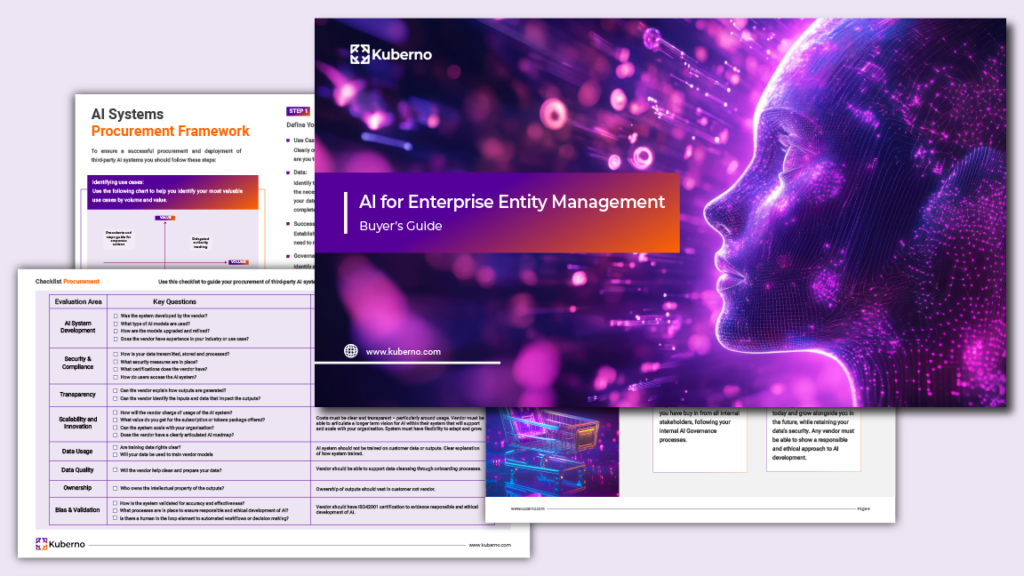Imagine this: a multinational organisation, operating in dozens of jurisdictions, navigating tax complexities, regulatory requirements, and governance challenges.
At the heart of it all is a hidden asset – legal entity data.
For too long, this critical information has been scattered across teams and buried in siloed systems, treated as a necessary but uninspiring part of compliance.
But what if this data could be something much bigger – a source of insight, agility, and growth for your entire organisation?
“Legal entities are the building blocks of organisations,” says Zoe Bucknell, CEO of Kuberno. “And yet, the data that surrounds them is one of the last untapped data lakes in enterprise.”
This is an opportunity for legal entity management teams to unlock the true value of entity data. Just as Salesforce reimagined how organisations use customer data, legal entity data is ready to step into the spotlight as a key driver of strategic transformation.
What Is Legal Entity Data and Why Does It Matter?
Legal entity data is the DNA of your organisation. It captures everything from corporate structures and ownership to compliance statuses and jurisdictional requirements. But here’s the problem: this invaluable information has historically been viewed through narrow, functional lenses by different teams, such as tax, legal, and governance.
“When you think about it holistically, legal entity data tells the story of your organisation,” Bucknell explains. “But because it’s fragmented across functions, organisations rarely get to see the full picture or realise its value.”
This lack of a unified view creates several challenges:
- Missed filings or misaligned records that lead to regulatory risks and reputational concerns.
- Redundant entities that drain resources can go unnoticed, particularly in post-M&A scenarios.
- Opportunities for strategic growth or efficiency are buried under layers of disconnection.
- Within these challenges lies a transformative opportunity.
Why the Time Is Right to Act
Several forces are aligning to make the centralisation of legal entity data not just important, but essential:
1. Increasing Regulatory Complexity
Governments and intergovernmental organisations such as the OECD are demanding more transparency, not only around ultimate ownership, but also around issues such as global tax compliance and ESG reporting. Organisations that streamline their data will be best positioned to respond with confidence.
2. Board-Level Focus on Risk, ESG, and Transparency
As Boards sharpen their focus on risk, operational efficiency, and rapidly shifting compliance and reporting requirements – legal entity management teams have a golden opportunity to deliver actionable insights and strategic solutions. The key? Access to the right data.
3. AI and Technology Transforming Data
Today’s tools can make sense of sprawling, unstructured data lakes. By adopting AI-driven platforms, organisations can surface trends, insights, and opportunities that would have previously gone unnoticed.
“AI doesn’t respect silos,” says Bucknell. “It helps us analyse and visualise data holistically and identify inefficiencies, risks, or patterns that empower smarter decision-making.”
Unlocking the Value of Legal Entity Data
Turning legal entity data into a strategic asset requires three critical steps:
Step 1: Centralise Your Data
The first step is breaking down silos and creating a single source of truth for legal entity data. This allows all teams – from governance to tax – to access and collaborate on the same, up-to-date information.
Step 2: Use AI to Surface Insights
AI transforms how we see and use data. It can:
- Highlight redundancies, such as overlapping entities after an acquisition.
- Flag potential compliance risks before they become problems.
- Provide a clear, visual understanding of global organisational structures.
“This is about moving beyond managing data to truly unlocking its potential,” says Bucknell.
Step 3: Drive Cross-Functional Collaboration
Legal entity data is no longer just the concern of one team. By creating shared frameworks, organisations can ensure tax, legal, finance, and compliance teams all work together seamlessly. This cross-functional approach enables businesses to act with greater speed and confidence.
Entity Data’s Salesforce Moment
Entity Data is increasingly seen as an enabler of strategic decisions. Legal entity data provides the clarity leaders need to identify opportunities, reduce risks, and align decisions across the organisation.
Twenty-five years ago, Salesforce revolutionised how businesses thought about customer data. It moved CRM from a fragmented, administrative process to a central, strategic tool, elevating the role of the marketing teams who were historically the key “keepers” of customer data. Legal entity data is poised for the same transformation and the legal and governance teams who are considered the “keepers” of entity data have the same opportunity to elevate their role.
As Zoe Bucknell puts it: “Legal entity data is the fuel for smarter decisions, stronger collaboration, and future growth. This is Entity Data’s Salesforce moment.”
Are you ready to unlock the potential of your legal entity data? Let’s talk about how Kuberno can help you lead the way.








